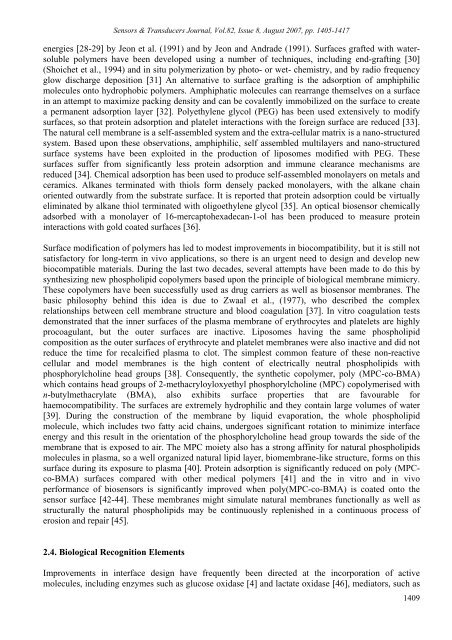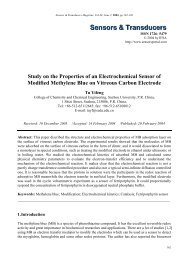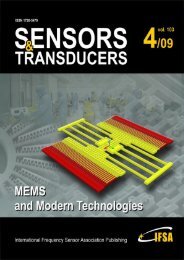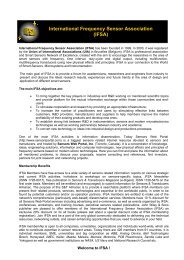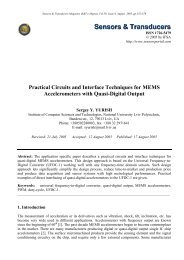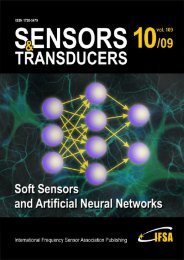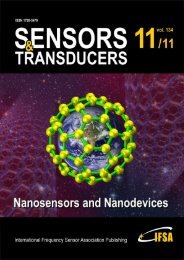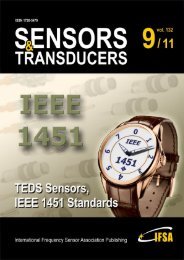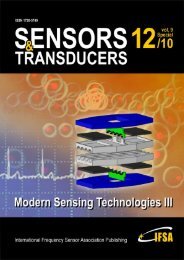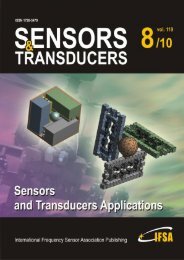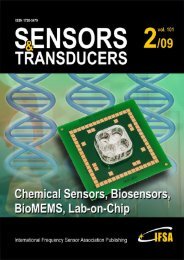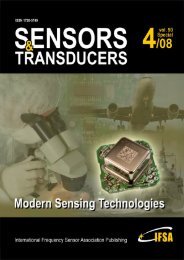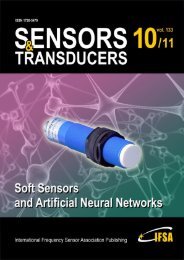Bio-Techniques in Electrochemical Transducers: an Overview
Bio-Techniques in Electrochemical Transducers: an Overview
Bio-Techniques in Electrochemical Transducers: an Overview
Create successful ePaper yourself
Turn your PDF publications into a flip-book with our unique Google optimized e-Paper software.
Sensors & <strong>Tr<strong>an</strong>sducers</strong> Journal, Vol.82, Issue 8, August 2007, pp. 1405-1417<br />
energies [28-29] by Jeon et al. (1991) <strong>an</strong>d by Jeon <strong>an</strong>d Andrade (1991). Surfaces grafted with watersoluble<br />
polymers have been developed us<strong>in</strong>g a number of techniques, <strong>in</strong>clud<strong>in</strong>g end-graft<strong>in</strong>g [30]<br />
(Shoichet et al., 1994) <strong>an</strong>d <strong>in</strong> situ polymerization by photo- or wet- chemistry, <strong>an</strong>d by radio frequency<br />
glow discharge deposition [31] An alternative to surface graft<strong>in</strong>g is the adsorption of amphiphilic<br />
molecules onto hydrophobic polymers. Amphiphatic molecules c<strong>an</strong> rearr<strong>an</strong>ge themselves on a surface<br />
<strong>in</strong> <strong>an</strong> attempt to maximize pack<strong>in</strong>g density <strong>an</strong>d c<strong>an</strong> be covalently immobilized on the surface to create<br />
a perm<strong>an</strong>ent adsorption layer [32]. Polyethylene glycol (PEG) has been used extensively to modify<br />
surfaces, so that prote<strong>in</strong> adsorption <strong>an</strong>d platelet <strong>in</strong>teractions with the foreign surface are reduced [33].<br />
The natural cell membr<strong>an</strong>e is a self-assembled system <strong>an</strong>d the extra-cellular matrix is a n<strong>an</strong>o-structured<br />
system. Based upon these observations, amphiphilic, self assembled multilayers <strong>an</strong>d n<strong>an</strong>o-structured<br />
surface systems have been exploited <strong>in</strong> the production of liposomes modified with PEG. These<br />
surfaces suffer from signific<strong>an</strong>tly less prote<strong>in</strong> adsorption <strong>an</strong>d immune clear<strong>an</strong>ce mech<strong>an</strong>isms are<br />
reduced [34]. Chemical adsorption has been used to produce self-assembled monolayers on metals <strong>an</strong>d<br />
ceramics. Alk<strong>an</strong>es term<strong>in</strong>ated with thiols form densely packed monolayers, with the alk<strong>an</strong>e cha<strong>in</strong><br />
oriented outwardly from the substrate surface. It is reported that prote<strong>in</strong> adsorption could be virtually<br />
elim<strong>in</strong>ated by alk<strong>an</strong>e thiol term<strong>in</strong>ated with oligoethylene glycol [35]. An optical biosensor chemically<br />
adsorbed with a monolayer of 16-mercaptohexadec<strong>an</strong>-1-ol has been produced to measure prote<strong>in</strong><br />
<strong>in</strong>teractions with gold coated surfaces [36].<br />
Surface modification of polymers has led to modest improvements <strong>in</strong> biocompatibility, but it is still not<br />
satisfactory for long-term <strong>in</strong> vivo applications, so there is <strong>an</strong> urgent need to design <strong>an</strong>d develop new<br />
biocompatible materials. Dur<strong>in</strong>g the last two decades, several attempts have been made to do this by<br />
synthesiz<strong>in</strong>g new phospholipid copolymers based upon the pr<strong>in</strong>ciple of biological membr<strong>an</strong>e mimicry.<br />
These copolymers have been successfully used as drug carriers as well as biosensor membr<strong>an</strong>es. The<br />
basic philosophy beh<strong>in</strong>d this idea is due to Zwaal et al., (1977), who described the complex<br />
relationships between cell membr<strong>an</strong>e structure <strong>an</strong>d blood coagulation [37]. In vitro coagulation tests<br />
demonstrated that the <strong>in</strong>ner surfaces of the plasma membr<strong>an</strong>e of erythrocytes <strong>an</strong>d platelets are highly<br />
procoagul<strong>an</strong>t, but the outer surfaces are <strong>in</strong>active. Liposomes hav<strong>in</strong>g the same phospholipid<br />
composition as the outer surfaces of erythrocyte <strong>an</strong>d platelet membr<strong>an</strong>es were also <strong>in</strong>active <strong>an</strong>d did not<br />
reduce the time for recalcified plasma to clot. The simplest common feature of these non-reactive<br />
cellular <strong>an</strong>d model membr<strong>an</strong>es is the high content of electrically neutral phospholipids with<br />
phosphorylchol<strong>in</strong>e head groups [38]. Consequently, the synthetic copolymer, poly (MPC-co-BMA)<br />
which conta<strong>in</strong>s head groups of 2-methacryloyloxyethyl phosphorylchol<strong>in</strong>e (MPC) copolymerised with<br />
n-butylmethacrylate (BMA), also exhibits surface properties that are favourable for<br />
haemocompatibility. The surfaces are extremely hydrophilic <strong>an</strong>d they conta<strong>in</strong> large volumes of water<br />
[39]. Dur<strong>in</strong>g the construction of the membr<strong>an</strong>e by liquid evaporation, the whole phospholipid<br />
molecule, which <strong>in</strong>cludes two fatty acid cha<strong>in</strong>s, undergoes signific<strong>an</strong>t rotation to m<strong>in</strong>imize <strong>in</strong>terface<br />
energy <strong>an</strong>d this result <strong>in</strong> the orientation of the phosphorylchol<strong>in</strong>e head group towards the side of the<br />
membr<strong>an</strong>e that is exposed to air. The MPC moiety also has a strong aff<strong>in</strong>ity for natural phospholipids<br />
molecules <strong>in</strong> plasma, so a well org<strong>an</strong>ized natural lipid layer, biomembr<strong>an</strong>e-like structure, forms on this<br />
surface dur<strong>in</strong>g its exposure to plasma [40]. Prote<strong>in</strong> adsorption is signific<strong>an</strong>tly reduced on poly (MPCco-BMA)<br />
surfaces compared with other medical polymers [41] <strong>an</strong>d the <strong>in</strong> vitro <strong>an</strong>d <strong>in</strong> vivo<br />
perform<strong>an</strong>ce of biosensors is signific<strong>an</strong>tly improved when poly(MPC-co-BMA) is coated onto the<br />
sensor surface [42-44]. These membr<strong>an</strong>es might simulate natural membr<strong>an</strong>es functionally as well as<br />
structurally the natural phospholipids may be cont<strong>in</strong>uously replenished <strong>in</strong> a cont<strong>in</strong>uous process of<br />
erosion <strong>an</strong>d repair [45].<br />
2.4. <strong>Bio</strong>logical Recognition Elements<br />
Improvements <strong>in</strong> <strong>in</strong>terface design have frequently been directed at the <strong>in</strong>corporation of active<br />
molecules, <strong>in</strong>clud<strong>in</strong>g enzymes such as glucose oxidase [4] <strong>an</strong>d lactate oxidase [46], mediators, such as<br />
1409


